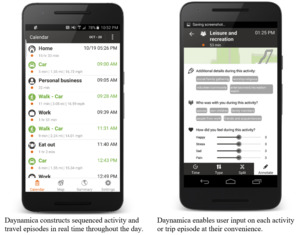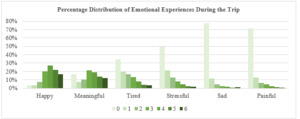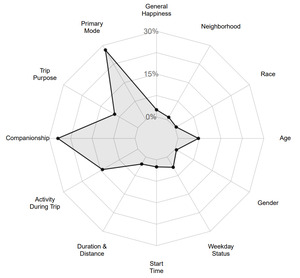Research Question and Hypotheses
Trip happiness, defined as people’s emotional well-being during daily trips, can play a significant role in people’s general health and wellness. Using unique smartphone-based survey data, this research examines how trip and personal characteristics may affect trip happiness in the Minneapolis–St. Paul metropolitan region in the United States. The research contributes to the limited literature on travel behavior and emotional well-being available (Raveau et al. 2016; De Vos 2018; Zhu and Fan 2018a, 2018b; Chen et al. 2019). The research questions include:
-
How does trip happiness vary across trip categories?
-
How does trip happiness vary across population groups?
The corresponding research hypotheses are:
-
Trip happiness is significantly associated with a number of trip characteristics, including mode, purpose, companionship, temporal characteristics, distance, duration, and activities during the trip.
-
Trip happiness is significantly associated with a number of personal characteristics, including gender, age, race, income, education, family structure, neighborhood location, and general happiness levels.
Methods and Data
To collect trip happiness data, the study used the Android-based smartphone application Daynamica, previously SmarTrAC (Fan et al. 2015). Daynamica is capable of detecting activities and trips in real time to construct sequenced activity/trip episodes throughout the day (Figure 1, left). It also allows the user to annotate the detected activities/trips with additional information such as emotional experiences during each activity/trip at their convenience (Figure 1, right).
A Daynamica-based trip happiness survey was conducted in the Minneapolis–St. Paul metropolitan region between October 17, 2016 and October 25, 2017. The survey successfully recruited 372 residents from six neighborhoods in the region. Each participant carried a smartphone equipped with the Daynamica app for seven consecutive days. Among the 372 participants, 350 provided valid activity and trip data. The final sample used in the analysis included a total of 9,541 completed trips generated by the 350 survey participants.
Table 1 summarizes the characteristics of the 350 survey participants. The majority of the participants were female (67%), home owners (72%), married (61%), white (78%), pretty happy in general (57%), held a bachelor’s degree or higher (71%), and had an annual household income greater than US$50,000 (64%).
For each trip episode, the Daynamica app prompts the respondent to rate the intensity of six different emotion variables, using a scale of 0–6: happy, pain, sad, tired, stressful, and meaningful. The questions were phrased similarly for rating each of the six variables. For example, the question for the “happy” dimension was: “From 0 to 6, where a 0 means you were not happy at all and a 6 means you were very happy, how happy did you feel during this time?”
Figure 2 shows the percentage distribution of the six variables. During most trips, people reported relatively high levels of happy and meaningful emotions. Over 90% of the trips were associated with some level of happiness, and over 80% of the trips were associated with some level of meaningfulness. In contrast, less than 30% of the trips were associated with any levels of sad or painful feelings.
Overall trip happiness is measured by a composite index score that takes into account all six emotion variables. Following the concept of average net affect, trip happiness is average positive feelings less average negative feelings. The formula to calculate trip happiness follows. The calculated trip happiness scores in this study range between –6 and +6 and have a mean of 2.55 and a standard deviation of 1.92.
Trip Happiness =Average Net Affect=Happy+Meaningful2−Tired+Stressful+Sad+Painful4
In addition to trip happiness, Daynamica records detailed spatiotemporal information about each trip, including the trip start and end times, the date, locations of the trip origin and destination, and the trip trajectory. The recorded information also includes the transportation modes involved in the trip, the main trip purpose, trip companionship, as well as activities performed during the trip.
Table 2 summarizes the characteristics of the trip data. The majority of the trips were car trips (68%), trips made alone (57%), trips made between 9:00 a.m. and 4:00 p.m. (52%), and trips made on weekdays (76%). The most common trip purpose category was to return home (30%), the largest activity-during-trip category was listening to music (41%), and the largest trip duration and distance categories were respectively 5–15 minutes (44%) and 3–10 miles (33%).
To estimate the effects of trip- and person-level factors on the trip happiness score (i.e., the average net affect score), we used a linear mixed effects model with a random intercept for each individual. We chose this model for two reasons: (1) to account for dependence between multiple trip entries from the same individual, and (2) the dependent variable is the net affect score, which is continuous, ranging from –6 to +6.
A full model was fit with all independent variables of interest included as fixed effects, and a final model was chosen by removing factors that were not significant at the 0.05 level. P-values were calculated using Satterthwaite’s degrees of freedom and were not adjusted for multiple comparisons. The factors removed from the final model include education, income, home ownership, and family structure. Race was kept as a factor in the final model because one of the race categories, Black, positively predicts trip happiness at a p-value of 0.056.
Two R2 analogues for mixed effects models were used to assess goodness-of-fit for each model: (1) marginal R2, which measures the proportion of variance explained by the fixed effects; and (2) conditional R2, which measures the proportion of variance explained by both the fixed and random effects (Nakagawa and Schielzeth 2013). Analyses were completed in R version 3.5.1 (R Core Team 2018), using the lme4 package model estimation (Bates et al. 2015), the lmerTest package for calculating Satterthwaite’s degrees of freedom and p-values (Kuznetsova, Brockhoff, and Christensen 2017), and the MuMIn package for calculation of the pseudo-R2 values (Barton 2018).
Findings
Table 3 presents the results from the two linear mixed effects models: One is the full model with all variables included, and the other is the final model with deliberately reduced variables. The R2 statistics show that the full and final models have similar levels of goodness-of-fit. In addition, conditional R2 is much higher than marginal R2 in both models, indicating the importance of allowing both fixed and random effects.
For the purpose of clarity, results from the final models are interpreted as follows. Results from the full model are not interpreted but are reported in Table 3 for reference purposes only. According to the final model in Table 3, trip mode, purpose, duration, distance, companionship, activities during the trip, and temporal characteristics of the trip all significantly affect trip happiness in the following manners:
-
Mode: Biking and walking trips have significantly higher happiness ratings than car trips. There is no significant difference in trip happiness among car, bus, and rail trips.
-
Purpose: Trips made for eating out and leisure purposes are significantly rated happier than return home trips and other nondiscretionary trips such as education, personal business, and shopping trips.
-
Temporal Characteristics: Trips made earlier than 6:00 a.m. and later than 7:00 p.m. are rated significantly less happy than trips made during other times of the day. Weekday trips are rated significantly less happy than weekend trips.
-
Companionship: Trips made alone or with coworkers are rated significantly less happy than trips made with family and/or friends.
-
Activities during Trip: Trips during which people reported talking, relaxing, and listening to music are rated significantly happier than trips where people are working, reading, or doing nothing.
-
Trip Length: Trips with a duration of between 15 and 30 minutes are rated the happiest, and trips with a distance longer than 10 miles are rated the most unhappy.
Among various personal factors, age, gender, neighborhood, and general happiness of the person significantly affect trip happiness at the significance level of 0.05. Male, older adults (age >50), and people who reported being generally happy in their lives had higher levels of trip happiness. Residents in Near North and St. Anthony Park have lower levels of trip happiness than residents in other neighborhoods in the study. Race is not significant in most cases, but one of the race variables, Black, positively predicts trip happiness with a p-value of 0.056. Income, education, home ownership, and family structure were excluded from the final model because they show no association with trip happiness.
Figure 3 shows a variable importance radar chart indicating the percentage of explained variability in the happiness outcome attributable to 12 different sets of factors. Among the trip-level factors, mode and companionship explain the greatest amount of variability in trip happiness. Among personal factors, age explains the most, followed by general happiness of the individual. Race, gender, and neighborhood have modest effects on trip happiness. Overall, trip-level characteristics are much more important than person-level characteristics in predicting trip happiness.
Acknowledgments
This study was funded by the Sustainable Research Network project of the US National Science Foundation: Integrated Urban Infrastructure Solutions for Environmentally Sustainable, Healthy and Livable Cities. (Award #: 1444745).
Dr. Yingling Fan is cofounder and Chief Executive Officer of Daynamica, Inc. Dr. Julian Wolfson is cofounder and Chief Technology Officer of Daynamica, Inc. They hold equity and royalty interests in Daynamica along with the University of Minnesota, pursuant to the exclusive license agreement involving the software program that provides smartphone solutions for travel and activity capturing. These interests have been reviewed and managed by the University of Minnesota in accordance with its Conflict of Interest policies.






